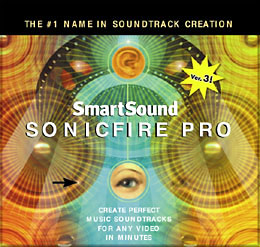

Review - Audio Application April 5, 2004
Review - Sonic Fire Pro 3.1


Review - Audio Application April 5, 2004
Review - Sonic Fire Pro 3.1
Review By Steve Douglas
The search for copyright free music has changed quite a bit over the years. No longer is it necessary to buy large libraries of music, paying for and/or getting cuts that you might not want. Now many editors can simply go online and pay for only the cut or cuts they want. They, through programs like Sonic Fire Pro, can now create and customize their own music selections to match that of their videos or films.
While Final Cut Pro 4 has come out with a super music creation application in Soundtrack, it is very time consuming to create complete musical pieces from scratch. While I find Soundtrack a whole lot of fun and extremely addictive to use, I find that I still utilize the Sonic Fire Program a great deal for its simplicity of use , large available library and the incredible speed by which I can create a perfectly timed finished product. The quickness of creation as you customize your music, as well as the high quality of the orchestration itself is a primary reason to consider having Sonic Fire Pro as one of your essential editing tools.
Many music discs from various copyright free music companies come with multiple versions and lengths of individual pieces, often at 10, 30 and 60 sec lengths. That is fine if your video piece or clip also comes in at those lengths. If not, you are stuck key framing fades to match or figuring out how to loop two clips on just the right beat to make a longer piece. Not too difficult to do but it is time consuming.
That's when I discovered the Smart Sound software, which has evolved over the years to become Sonic Fire Pro 3.1. Sonic Fire Pro comes equipped with numerous tools to help the audio editor in all of us and works flawlessly with Quicktime, MPEG or AVI files. The entire program is designed to help the editor create original, copyright free music that will fit whatever video project it is that you are working on and fit it to the exact length and frames that you want.
Sonic Fire Pro allows you to pick and choose several methods to customize your music. One unique thing about Sonic Fire Pro is that, like its predecessors, it utilizes blocks of music that the editor can use and manipulate in any way or order they find fitting to their needs. For those not musically oriented, these blocks of orchestration provide easy to identify symbols to indicate which blocks would be good to start and/or end any particular piece.
Sonic Fire offers discs of music centered on a particular theme or genre. They call these discs Palettes with one disc perhaps being blues oriented, another party or wedding oriented music, while others cover a wide range of music representing different cultures and countries, industrial powerhouse themes, orchestral scoring, Foley FX sounds and far too many more to mention here. Smart Sound regularly comes out with new discs every couple of months so expanding your library to use their software is an easy option. Don't want to buy an entire disc? Simple, just go online, something you can do from within the Sonic Fire interface. Demo any number of music and FX options and buy only the piece you need for a reasonable price. No longer is it necessary to wait for days or weeks for your order to arrive while your video project sits there. You can now have the piece you need within seconds.
So, just how easy is it to work within Sonic Fire? Very, the program is fairly intuitive. Opening Sonic Fire brings up the entire interface consisting of the timeline, video window, and music blocks.
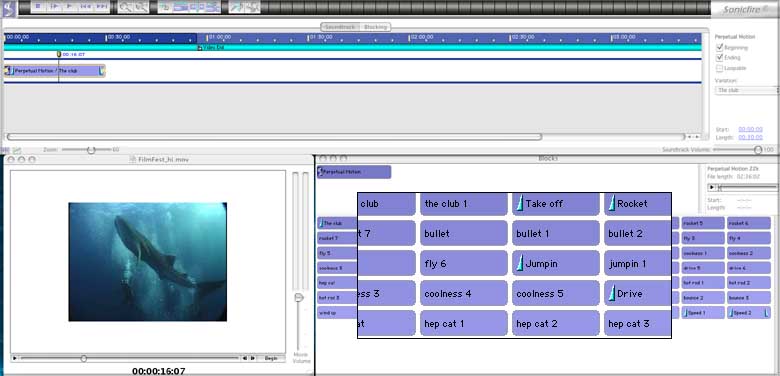
Once opened the simplest way to score your film is by using the Sonic Fire Pro's Maestro. The Maestro has been completely redesigned from previous versions providing the user with more search criteria and flexibility in selecting the right music.
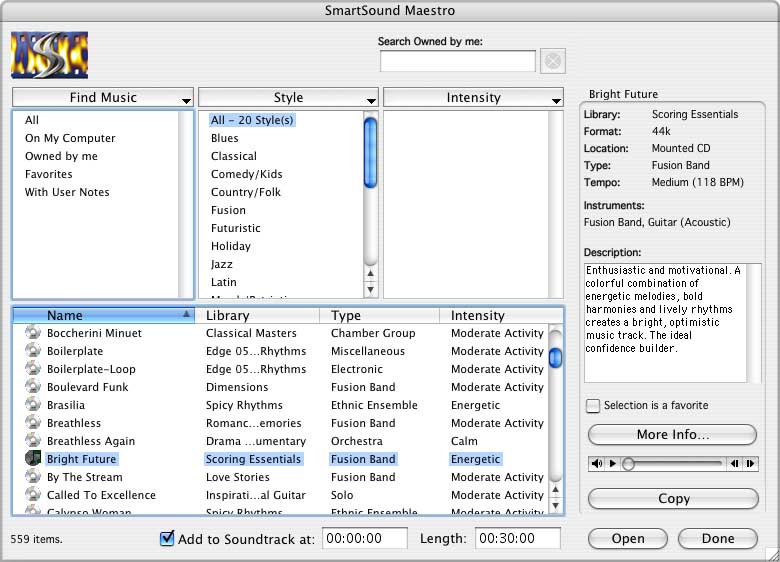
Simply click on the Maestro under the top timeline menu. Then it is up to you. You can instruct it to provide previews of Smart Sound music that you already own, go to a tunes or FX that you have previously marked as being favorites, or go to tunes that have already been copied on to your computer. Another method of selection is to click on a particular style of music that you had in mind, when you do this the maestro will select all the tunes that you have in your library that meet your criteria. Before selecting a title you can listen to the piece in the preview window, if it meets your standards you simply click done and it will open in your timeline as both a complete piece in the Sonic Fire Pro timeline as well as a series of blocks in the blocks window.

Now the customization is up to you. You can fine tune the entire piece in your timeline or delete it and create your own unique version by dragging music blocks from the blocks window and dropping them in the timeline window.

Each block is individually named and numbered so that you don't get confused and forget which is which. In addition, blocks, which are denoted as being good to begin or end music pieces, have their own icons which help you find just the right block. You can have a lot of fun working with this and create pieces that are uniquely your own.
A real help when working with Sonic Fire Pro 3.1 is that you can import video into their video window and customize your music piece so that it is properly synched within your project.
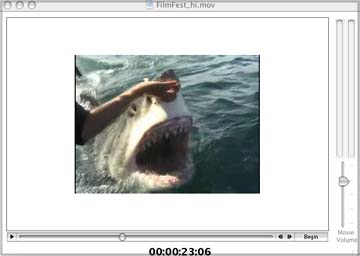
Now suppose you're in a rush, feeling uninspired, lazy or just want to create a good music piece the simplest way possible. That's when you forgo the Music Maestro and utilize the Sonic Fire Pro Assistant. Here you can create a perfectly timed piece down to almost the exact frame length that you require. The assistant easily leads you through the entire process and all you have to do is decide which music you like best and how long it needs to be. The assistant will do all the work. Simply click on the Assistant, also under the timeline menu, and it will bring up a window, which guides you through the easy steps.
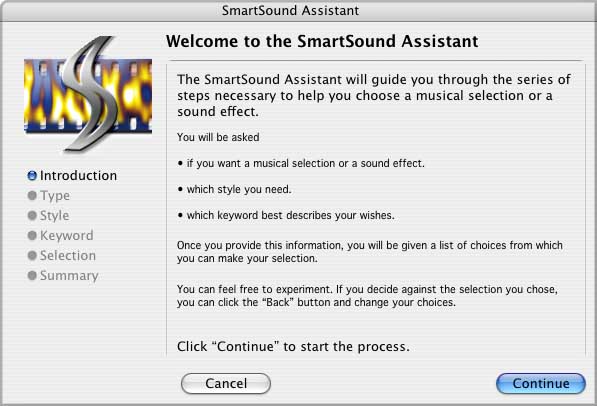
This window guides you to the next step and asks whether you are looking for Sound Effects or Music.
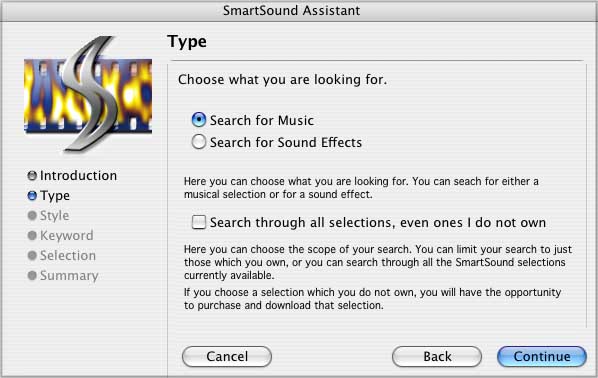
This leads you to the second window that asks you to denote the style of music from a wide variety of choices.
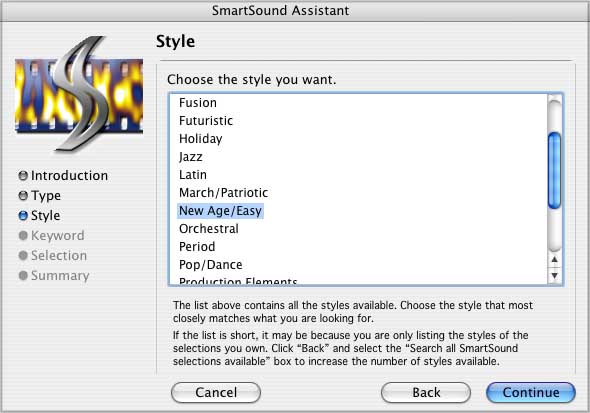
The third window then asks you to choose a keyword, which reflects the mood of the selection you desire. These keywords will often reflect and fit any number of pieces that you might have in your library or that are available to you on line. Unfortunately, I found this to be a major pain. If I had a certain piece in mind or if I had forgotten the title and had failed to mark it as a favorite but remembered it as "calm" I would highlight that keyword but not find it listed. This is because the folks at Sonic Fire might have deemed it as 'ethereal'. Thus, if I had a particular piece of music I wanted the Assistant to cut for me, I might have to try a number of keywords before I could actually get to the title I was looking for. The more I used it, the more annoyed I got. Never the less, these keywords narrow your choices down for you if you are not sure of what to select.
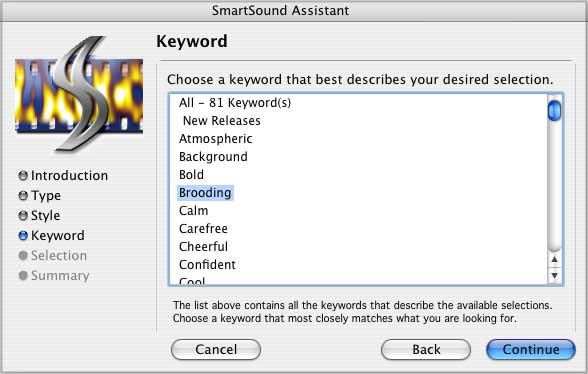
The fourth window finally focuses upon the selections that meet your criteria. If the selection has already been downloaded into the computer you can preview and compare them. If not, then you will have to insert the disc to preview.
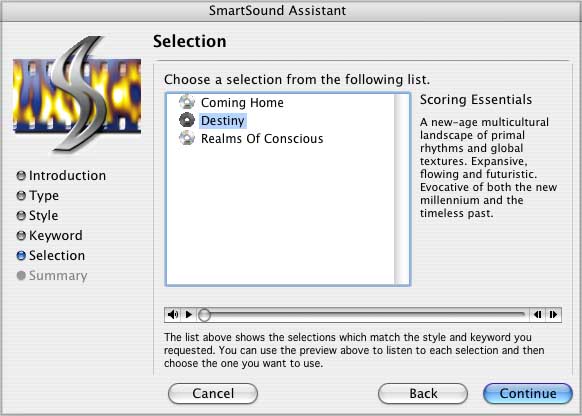
Finally, you have the piece you have selected but you are not quite done yet. At this point you instruct the Sonic Fire Pro assistant to determine the exact length of your selection.
Click 'Done' and your selection immediately opens up in the timeline as a finished piece. Its start and end points will be just the length you asked for and sound professionally scored. This might sound like a long process but it really is not. It goes quickly and is easy to do.

This brings us to the quality of the music itself. Early discs from the old Smart Sound days sometimes sounded too artificial to me. Reliance upon synthesizer created pieces was not cutting it. In addition, several cuts I had already had in my library from Music Bakery or other copyright free music companies were repeated within the Smart Sound palettes and I didn't like the idea of paying for something that was just a copy of a piece I already bought and paid for. Those days are happily in the past, as their new palettes of music sound just great. I recently picked up 4 of their most recent palettes, Across Borders, Tranquil Journeys, Nostalgic Nights and Uplifting Ideas and they are all just fine. The use of real instrumentation makes all the difference to me. In addition, the very fact that I can so easily customize the length and feel of each piece, or even change the piece around by manipulating the blocks of music to my own liking in a quick and efficacious manner makes Sonic Fire Pro one really valuable editing application.
Sonic Fire Pro provides the same palettes in two different sampling rates. One is a 22k 16-bit stereo which is just fine for the casual hobbyist or for those using Sonic Fire for outputting to the Web. These discs generally sell for $49.95 which can be considered a bargain when you look at the costs of copyright free music elsewhere. The professional 44k version of the discs sells for $99.95 and come with a code number that gives you that access. The QuickTime structure of Sonic Fire will automatically resample the 44.1k audio to 48k so you won't find any loss of quality.
The Sonic Fire Pro 3.1 software program itself sells for $299.00 and comes with two 44k music palettes. They also offer additional bundles and collections of music packages for both Mac and Windows users. Demo versions of the Sonic Fire Pro software are available on the www.smartsound.com site. Once there you can also audition and order music palettes to your hearts content. It is pretty nice to be able to hear what you're getting prior to paying for it.
All in all, Sonic Fire Pro 3.1 is a fine music application with little not to like. While the initial outlay for the program and supplemental palette discs can eventually add up, you have the options of only buying the cuts you want or adding to your library as the need deems necessary. While it is possible that you will hear the music you've used on someone else's project, that you can so completely customize any of the orchestrations allows you to create pieces that are completely your own. There's no arguing with that.
- Steve
Steve Douglas has been an underwater videographer and contributor to numerous film festivals around the world. The winner of the 1999 Pacific Coast Underwater Film Competition and the 2003 IVIE competition, Steve has also worked on the feature film "The Deep Blue Sea" and is one of the principal organizers of the San Diego UnderSea Film Festival. Steve leads both African safari and underwater filming expeditions and is based in San Diego. Feel free to contact him.
Review copyright © Steve Douglas 2004
© 2000 -2004 Apple
Computer, Inc. All rights reserved. Apple, the Apple logo, Final
Cut Pro, Macintosh and Power Mac
are either registered trademarks or trademarks of Apple. Other
company and product names may be trademarks of their respective
owners.
All screen captures, images, and textual references are the property and trademark of their creators/owners/publishers.